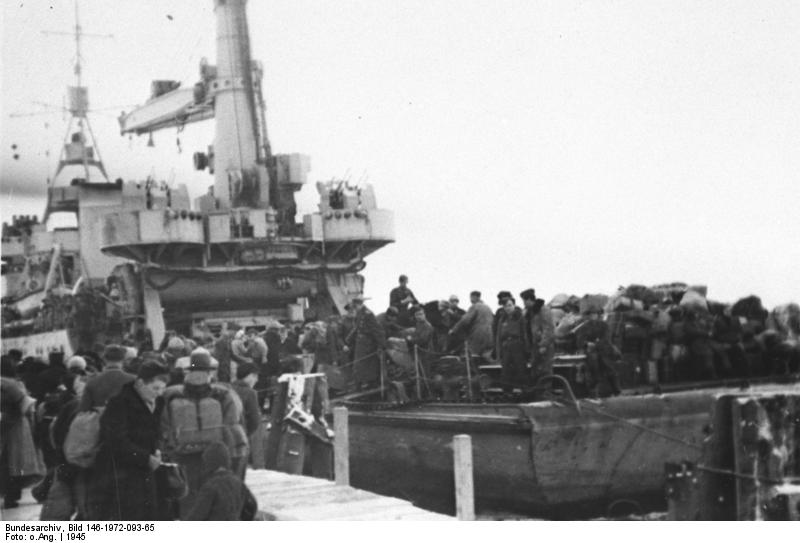Refugee ships
„What the commercial ships turned refugee transporters have been accomplished
in these dramatic 125 days cannot be duly appreciated ..."
Hans Georg Prager
In early 1945 the attacking wedge of the Red Army, the 1st Baltic Front, already advanced westward in East Prussia against Königsberg and the port of Pillau.
The 2nd and 3rd White Russian Front, situated in the south, in the beginning moved westward, then turned northward to the Baltic Sea.
With this operation East Prussia has been encircled and the population could not flee westward, the only way out was through the ports of the Baltic Sea.
The remaining German troops were pushed towards the shore. They defended the encircled ports with great loss, making possible for many people to flee the danger zone onboard ships. In this way appr. 2,5 millions people could escape to the West.
Many thousands who thought themselves saved on the ships died a terrible death in the ice-cold water of the Baltic Sea. Although the Allies knew very well that the ships carried mainly women, children and elderly, they attacked them with bombs, rockets, deck guns and torpedoes. Even hospital ships full of seriously injured, marked by the Red Cross, were sunk without mercy. A total of more than 250 ships found a watery grave.
40,000 dead
While the drama of the "Titanic" moves thousands of movie-goers to tears, the general public shows no interest in the biggest ship catastrophes of all time, with the number of victims twice or thrice that much.
The 9,343 victims of the "Wilhelm Gustloff", a 7,000 victims of the "Goya", the 5,594 victims of the "Cap Arcona", the 3,608 victims of the "Steuben", the 2,950 victims of the "Thielbeck", the 1,500 victims of the "Orion", the 970 victims of the "Karlsruhe", the 956 victims of the "Neuwerk" and the 8078 victoms of a further 242 refugee ships did not die a less terrible death.
Their bodies were lacerated by torpedoes or bombs, they drowned in the ice-cold water of the Baltic Sea, trampled each other to death on the overcrowded corridors of the sinking ships, burnt under the deck, suffocated by smoke of fires or were shot dead in the water by low-flying aircraft.
Among them, the majority were women and children from East Prussia, West Prussia or Pomerania who fled the Red Army.
But there were also many injured who thought themselves on the way to safety.

in these dramatic 125 days cannot be duly appreciated ..."
Hans Georg Prager
In early 1945 the attacking wedge of the Red Army, the 1st Baltic Front, already advanced westward in East Prussia against Königsberg and the port of Pillau.
The 2nd and 3rd White Russian Front, situated in the south, in the beginning moved westward, then turned northward to the Baltic Sea.
With this operation East Prussia has been encircled and the population could not flee westward, the only way out was through the ports of the Baltic Sea.
The remaining German troops were pushed towards the shore. They defended the encircled ports with great loss, making possible for many people to flee the danger zone onboard ships. In this way appr. 2,5 millions people could escape to the West.
Many thousands who thought themselves saved on the ships died a terrible death in the ice-cold water of the Baltic Sea. Although the Allies knew very well that the ships carried mainly women, children and elderly, they attacked them with bombs, rockets, deck guns and torpedoes. Even hospital ships full of seriously injured, marked by the Red Cross, were sunk without mercy. A total of more than 250 ships found a watery grave.
40,000 dead
While the drama of the "Titanic" moves thousands of movie-goers to tears, the general public shows no interest in the biggest ship catastrophes of all time, with the number of victims twice or thrice that much.
The 9,343 victims of the "Wilhelm Gustloff", a 7,000 victims of the "Goya", the 5,594 victims of the "Cap Arcona", the 3,608 victims of the "Steuben", the 2,950 victims of the "Thielbeck", the 1,500 victims of the "Orion", the 970 victims of the "Karlsruhe", the 956 victims of the "Neuwerk" and the 8078 victoms of a further 242 refugee ships did not die a less terrible death.
Their bodies were lacerated by torpedoes or bombs, they drowned in the ice-cold water of the Baltic Sea, trampled each other to death on the overcrowded corridors of the sinking ships, burnt under the deck, suffocated by smoke of fires or were shot dead in the water by low-flying aircraft.
Among them, the majority were women and children from East Prussia, West Prussia or Pomerania who fled the Red Army.
But there were also many injured who thought themselves on the way to safety.
